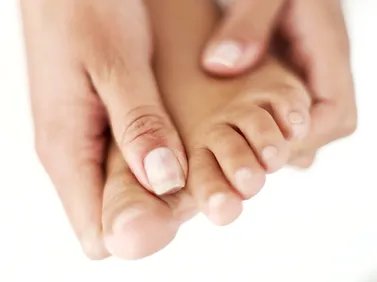Hallux Valgus
(bunions)
Injury Guide

Welcome to Latitude Physiotherapy, where we specialize in helping athletes like you overcome the challenges of Hallux Valgus, commonly known as bunions. We understand the impact this condition can have on your performance and overall quality of life. In this guide, we will delve into the symptoms, causes, and effective rehabilitation strategies tailored specifically for athletes. Let’s take the first step toward a pain-free and high-performance journey together!
Symptoms:
Hallux Valgus is a condition characterized by a bump at the base of the big toe, which deviates outward. Athletes affected by bunions often experience pain and discomfort during physical activity, such as running, jumping, or quick changes in direction. Swelling, inflammation, and sensitivity to touch are common in the bunion area. As the condition progresses, athletes may also notice a limited range of motion in the big toe, impacting their ability to push off or maintain balance. Additionally, altered foot mechanics can lead to the development of calluses or corns at the site of friction or pressure, causing further discomfort.
Anatomy:
Hallux Valgus primarily influences the metatarsophalangeal (MTP) joint, which is the joint where the metatarsal bones of the foot connect to the proximal phalanx bone of the big toe.
In individuals with bunions, the MTP joint undergoes changes due to various factors such as genetics, improper footwear, and repetitive stress. Over time, the joint becomes misaligned, causing the 1st metatarsal to deviate outward. This misalignment leads to structural changes and the formation of a bony bump at the base of the big toe.
The altered position of the big toe impacts the surrounding structures, including tendons, ligaments, and muscles. As the toe deviates, the tendons and ligaments that normally provide stability and support to the joint become stretched or weakened. This can result in pain, discomfort, and reduced range of motion.
The misalignment also affects the distribution of forces during weight-bearing activities. Excessive pressure is exerted on the inner edge of the foot, leading to increased stress on the MTP joint and surrounding tissues. This pressure imbalance can cause inflammation, swelling, and the development of calluses or corns.
Furthermore, the misalignment of the big toe can disrupt the normal biomechanics of the foot. This can impact how the foot functions during movement, leading to compensatory changes in gait and posture. These changes may further contribute to pain, instability, and a decreased ability to perform at optimal levels in athletic activities.
Causes:
Bunions can be caused by a combination of factors commonly associated with their development in athletes. Genetic factors play a role, as inherited foot structure and mechanics can contribute to the formation of bunions. Wearing tight or ill-fitting shoes that squeeze the toes together or have a narrow toe box can exacerbate the condition. Past injuries to the foot and ankle, and weakness further up the kinetic chain can also be an important contributing factor. Athletes engaging in activities involving repetitive foot movements or excessive pressure on the toes, such as running or dancing, may be at a higher risk of developing bunions.
Rehab Strategies:
At Latitude Physiotherapy, we offer evidence-informed rehabilitation strategies tailored to athletes with bunions, aiming to alleviate pain, restore function, and enhance athletic performance.
Pain management techniques can be employed, including cryotherapy, soft tissue mobilization, and taping. These methods reduce pain and inflammation, enabling athletes to participate in their sports without discomfort. We can also use manual therapy techniques to mobilize and restore joint mobility, improving the alignment and function of the big toe.
Tailored strengthening exercise programs target the muscles of the foot and lower leg, enhancing stability and promoting proper alignment. These exercises not only optimize athletic performance, but also reduce the risk of future injuries.
Through gait analysis and biomechanical assessment, we evaluate movement patterns to identify any underlying biomechanical issues. Based on the findings, strategies such as corrective devices i.e., toe spacers, or shoe modifications are provided to reduce excessive stress on the affected area.
Education and self-care strategies are integral to our approach. Athletes are empowered with knowledge and tools to manage their condition independently. This includes guidance on footwear selection, activity modification, and exercises for home maintenance.
At Latitude Physiotherapy, we understand the unique challenges athletes face when dealing with bunions. Our comprehensive and athlete-centered rehabilitation approach aims to relieve pain, improve function, and optimize performance. Don’t let bunions hold you back from reaching your athletic goals. Join our clinic and embark on a journey towards pain-free and high-performance living. Contact us to schedule a free consultation today!
Let’s
Work
Together
Ready to get started? Click here. General questions? Read our FAQ page. Have a specific question? Leave us a message!
